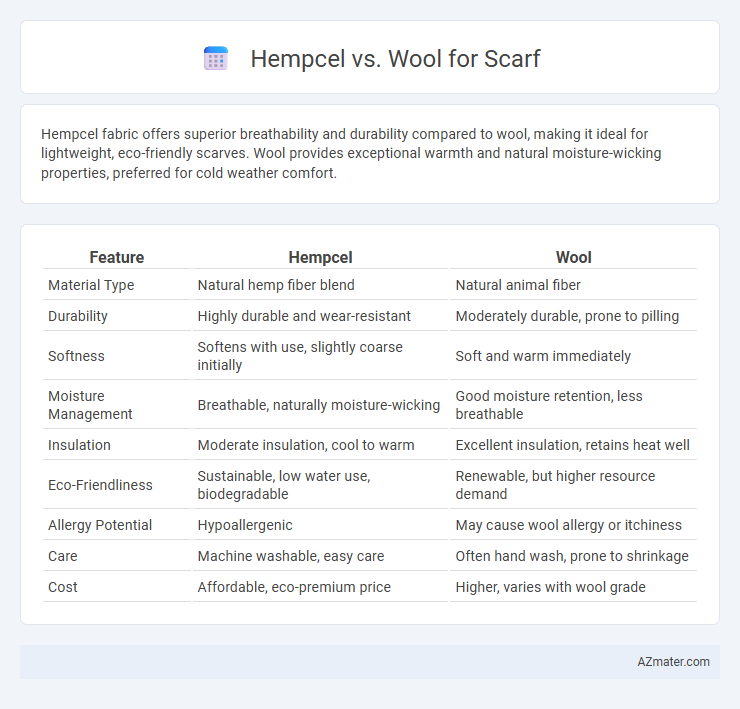Hempcel fabric offers superior breathability and durability compared to wool, making it ideal for lightweight, eco-friendly scarves. Wool provides exceptional warmth and natural moisture-wicking properties, preferred for cold weather comfort.
Table of Comparison
| Feature | Hempcel | Wool |
|---|---|---|
| Material Type | Natural hemp fiber blend | Natural animal fiber |
| Durability | Highly durable and wear-resistant | Moderately durable, prone to pilling |
| Softness | Softens with use, slightly coarse initially | Soft and warm immediately |
| Moisture Management | Breathable, naturally moisture-wicking | Good moisture retention, less breathable |
| Insulation | Moderate insulation, cool to warm | Excellent insulation, retains heat well |
| Eco-Friendliness | Sustainable, low water use, biodegradable | Renewable, but higher resource demand |
| Allergy Potential | Hypoallergenic | May cause wool allergy or itchiness |
| Care | Machine washable, easy care | Often hand wash, prone to shrinkage |
| Cost | Affordable, eco-premium price | Higher, varies with wool grade |
Introduction to Hempcel and Wool Scarves
Hempcel scarves are crafted from hemp fibers blended with cellulose, offering natural antibacterial properties, enhanced breathability, and durability ideal for sensitive skin. Wool scarves, derived from sheep's fleece, provide excellent insulation, moisture-wicking capabilities, and a soft texture that retains warmth in cold climates. Both materials present sustainable choices; hempcel emphasizes eco-friendly production with minimal pesticides, while wool supports renewable livestock farming.
Material Origins and Production Processes
Hempcel scarves are crafted from hemp fibers derived from the Cannabis sativa plant, renowned for sustainable growth with minimal pesticides and water usage. Wool scarves originate from the fleece of sheep, typically requiring shearing and extensive processing to clean and spin the fibers into yarn. The manufacturing of hempcel fabric emphasizes eco-friendly retting and decortication methods, whereas wool production often involves washing, carding, and sometimes chemical treatments to soften and stabilize the material.
Environmental Impact: Hempcel vs Wool
Hempcel scarves have a significantly lower environmental impact compared to wool due to hemp's rapid growth cycle, requiring less water and no pesticides. Wool production involves high greenhouse gas emissions and often excessive land use for grazing sheep, contributing to soil degradation. Choosing Hempcel supports sustainable textile manufacturing with reduced carbon footprint and resource consumption.
Texture and Comfort Comparison
Hempcel scarves offer a unique texture that is coarser and more durable compared to wool, providing a natural, breathable fabric ideal for warmer climates. Wool scarves deliver superior softness and insulating properties, making them exceptionally comfortable and warm for colder weather. Choosing between Hempcel and wool depends largely on desired comfort levels and temperature needs, with hempcel excelling in breathability and wool in plush warmth.
Warmth and Insulation Abilities
Hempcel scarves offer moderate warmth with excellent breathability and natural moisture-wicking properties, making them ideal for milder climates. Wool scarves provide superior insulation due to crimped fibers that trap heat efficiently, ensuring maximum warmth even in freezing temperatures. When comparing thermal performance, wool outperforms Hempcel in retaining body heat, while Hempcel excels in maintaining comfort through temperature regulation.
Durability and Longevity
Hempcel scarves offer superior durability compared to wool due to hemp fibers' natural resistance to wear, mildew, and UV damage, ensuring long-lasting performance. Wool, while soft and insulating, tends to weaken and pill over time with frequent use and washing. Hempcel's robust fiber structure maintains its strength and appearance, making it a more resilient choice for a scarf designed to withstand daily wear and environmental exposure.
Allergies and Skin Sensitivity
Hempcel fabric is naturally hypoallergenic and resistant to mold and mildew, making it ideal for individuals with allergies or sensitive skin, whereas wool can sometimes cause irritation or itchiness due to lanolin and coarse fibers. Wool contains natural oils that may trigger allergic reactions in some people, while Hempcel's smooth texture and breathable properties reduce the risk of skin irritation and rashes. Choosing Hempcel scarves can provide better comfort and minimize allergic responses compared to traditional wool scarves.
Style, Colors, and Design Options
Hempcel scarves offer a unique, eco-friendly style with natural earthy tones and subtle texture, appealing to those seeking sustainable fashion with a minimalist aesthetic. Wool scarves provide a broader spectrum of rich, vibrant colors and intricate patterns, catering to classic and contemporary tastes alike. Design options for Hempcel prioritize durability and breathability, while wool emphasizes warmth and softness, allowing diverse choices to suit both functional and stylistic preferences.
Care and Maintenance Requirements
Hempcel scarves require minimal maintenance, as hemp fibers are naturally resistant to mold and UV damage, allowing for easy machine washing in cold water without losing durability. Wool scarves need more delicate care, typically hand washing or dry cleaning to prevent shrinking and fiber damage, and they should be air-dried flat to maintain shape. Hempcel's moisture-wicking and quick-drying properties reduce odor buildup, while wool offers natural insulation but demands careful storage to avoid moth damage.
Price and Value for Money
Hempcel scarves generally offer a more affordable price point while maintaining durability and eco-friendliness, making them an excellent value for money. Wool scarves, though often more expensive, provide superior warmth and softness that can justify the higher cost for those seeking comfort and insulation. Comparing price per wear, Hempcel scarves deliver long-term savings due to their resilience, whereas wool's natural insulating properties cater to buyers prioritizing premium quality.

Infographic: Hempcel vs Wool for Scarf
 azmater.com
azmater.com